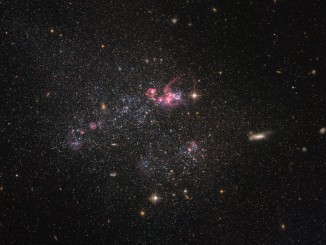
elliptical galaxy



Hubble sees a lopsided lynx
This galaxy, known as NGC 2337, resides 25 million light-years away in the high northern constellation of Lynx. NGC 2337 is an irregular galaxy, meaning that it lacks a distinct, symmetrical appearance. The galaxy was discovered in 1877 by the French astronomer Édouard Stephan who, in the same year, discovered the galactic group Stephan’s Quintet.

ALMA measures mass of black hole with extreme precision
Using the Atacama Large Millimetre/submillimetre Array (ALMA), a team of astronomers has delved remarkably deep into the heart of a nearby elliptical galaxy to study the motion of a disc of gas encircling the supermassive black hole at its centre. These observations provide one of the most accurate mass measurements to date for a black hole outside of our galaxy.

Lenticular galaxy conceals an eventful past
The elegant simplicity of NGC 4111, seen here in this image from the NASA/ESA Hubble Space Telescope, hides a more violent history than you might think. NGC 4111 is a lenticular, or lens-shaped, galaxy, lying about 50 million light-years from us in the constellation of Canes Venatici (The Hunting Dogs).

Hubble sees a distinctly disorganised dwarf galaxy
In this Hubble Space Telescope image we see an irregular dwarf galaxy known as UGC 4459, located in the constellation of Ursa Major (The Great Bear). While UGC 4459’s diffused and disorganised stellar population of several billion sounds impressive, this is small when compared to the 200 to 300 billion stars in the Milky Way.

Hubble views NGC 3610, a young elliptical galaxy with a disc
Elliptical galaxy NGC 3610 is the most prominent object in this amazing Hubble image — and a very interesting one at that! Discovered in 1793 by William Herschel, it was later found that this galaxy contains a disc. This is very unusual, as discs are one of the main distinguishing features of a spiral galaxy. And the disc in NGC 3610 is remarkably bright.
